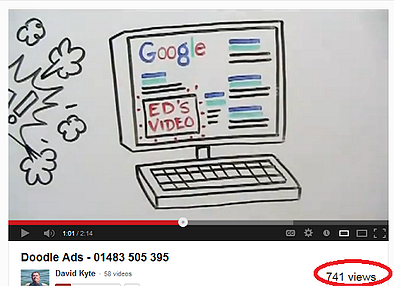
Do you know everything there is to know about YouTube? How many videos have you put out on your very own YouTube channel? Are they SEO optimized, using great tags, SEO in your title, professional grade? Did you go the expensive route or the do-it-yourself route? How has this worked out for you? Yes, well when it comes to the strengths of YouTube, I was struck by three major contradictions, or myths, if you will. I found these myths in my research and read a different angle in a SEOmoz article by Phil Nottingham, The Marketing Value of YouTube.
Myth 1:
YouTube belongs to Google, so they’re going to favor your site and the front page of Google will always look for a video regarding any subject of any keywords search for.
Myth 1 variation: YouTube can be a shortcut for those who want to get high rankings for free. Google owns YouTube and often automatically gives relevant YouTube videos first page ranking. If you have added your website URL in the video description section, chances are that YouTube can boost your site’s rankings dramatically and help you generate a lot of site traffic.
As you can see this myth and variation have to do with the fact that Google purchased YouTube. People have assumed that since that is true, Google will give a higher rank to a YouTube video. Therefore, if you have a YouTube video in your blog article, the Google will rank the article higher than if you did not have the video. Likewise if you have your URL link in your video, that fact will help your video pull more site traffic.
What does Nottingham have to say to this?
I don’t think so, as there is no barrier to entry to embed YouTube videos. If one person can embed a video, then anyone can embed said video - and the methods currently in place to determine “ownership” of YouTube videos with regards to a specific site are fairly rudimentary.
YouTube videos are, by and large, embedded in iframes since this is a lightweight, reliable, and mobile-friendly solution. When reading iframes, Google attribute the content to the original source if this page is indexable (i.e. not blocked via robots.txt).
Therefore, when You embed a YouTube video, you should essentially think of it as like a “vote,” or a link to that video on YouTube.com. There are many reasons why this is a good thing. Since embeds and links are definitely a ranking factor on YouTube, meaning embedding your YouTube videos will help them to rank better in YouTube and in Google universal search....but for the youtube.com URL, and not your own site.
In other words, whoever embeds your video into their article (you or someone else) will give Google juice to the video. You will not get Google juice to your website.
MYTH 2:
 For some reason, the majority of us seem to subconsciously assume that YouTube videos should be judged based on the number of views in the counter. Raw views have not been a significant ranking factor on YouTube for years and they don’t indicate anything other than a page load. As such, they are a vanity metric that we use to replace “audience numbers” from the traditional TV model.
For some reason, the majority of us seem to subconsciously assume that YouTube videos should be judged based on the number of views in the counter. Raw views have not been a significant ranking factor on YouTube for years and they don’t indicate anything other than a page load. As such, they are a vanity metric that we use to replace “audience numbers” from the traditional TV model.
In YouTube Marketing: #1 FAQ | Uhuru Network we read: First, it’s not all about the views. When it comes to YouTube marketing what you are really after are conversions. You want your viewers to take action. The concept of targeted views is important to understand. 15,000 views from people who have no intention of purchasing won’t be as effective with conversion as 1,500 targeted views. Viewers who are genuinely interested in your product or service are more likely to follow your link from YouTube to your web page.
So the number of views is not equal to the number of conversions? What does Nottingham have to add?
Don't measure views. No, really, don't measure views.
YouTube view counters are essentially the equivalent of “hits” on a website and are triggered when someone loads up a video, whether or not they actually watch the content through.
In judging the performance of our own sites, we’ve moved away from measuring website hits to look at more meaningful metrics of success, such as unique non-bouncing visits, time on site, and conversion rate. . . . .
Raw views have not been a significant ranking factor on YouTube for years and they don’t indicate anything other than a page load. As such, they are a vanity metric that we use to replace “audience numbers” from the traditional TV model.
The YouTube “estimated minutes watched” report and "average view duration" figures are a much more useful indicator of overall success that counts for bouncing visits.
Next Nottingham gives a typical example from one of his clients that showed that although the client received 415,000 views from all their videos, they got only 19 referrals, making a click though rate of 0.005%. You can’t tell the success of your videos by the number of views.
Myth 3:
YouTube videos will bring traffic to my website.
Nottingham has already given us an example, but there is more. Are people coming to YouTube to do research? Not at all, says Nottingham:
 The main reason people go to YouTube: to find and watch videos on the internet.
The main reason people go to YouTube: to find and watch videos on the internet.
YouTube is like "Inbound TV."
No matter how users get to YouTube - through Google universal search, via social media or by navigating directly to youtube.com in their browser - the intent is the same: watch a video.
By and large, people don’t go to YouTube to find products or services to buy; they don’t go there to get news, restaurant recommendations, or travel directions. They go there for one reason - to watch a video, with the goal of finding something informative or entertaining.

People aren’t using YouTube to help them find your product or service. Therefore, they are not likely to flip over to your website. That said, Nottingham also suggested that YouTube is like “Inbound TV”. This means that YouTube is a way for you to make friends with potential clients. Inbound marketing is a slow process, but don’t underestimate its value. When a client is comfortable with a brand, he will be more likely to buy from it over again. He is more likely to refer his friends. Some brands have generations of loyal customers. This is the true advantage of inbound marketing.
Did you create your video based on these myths? How do you feel about your videos now that you have a more realistic idea of the strengths of YouTube?
 Jaco Grobbelaar is the owner of BroadVision Marketing. BroadVision Marketing works with business owners to put in place inbound and outbound marketing strategies that consistently secure new clients. The BroadVision Marketing Training Center is located in Petaluma, CA and primarily serves companies in the San Francisco Bay area.
Jaco Grobbelaar is the owner of BroadVision Marketing. BroadVision Marketing works with business owners to put in place inbound and outbound marketing strategies that consistently secure new clients. The BroadVision Marketing Training Center is located in Petaluma, CA and primarily serves companies in the San Francisco Bay area.
Jaco can be reached at jaco@broadvisionmarketing.com or 707.766.9778 or connect with Jaco on Facebook - www.facebook.com/broadvisionmarketing - and LinkedIn - www.linkedin.com/in/JacoGrobbelaar
